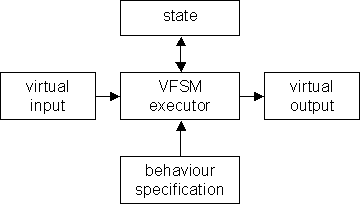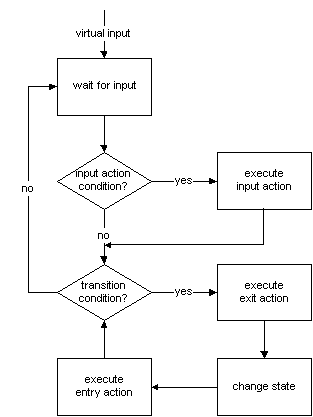StateWORKS: Virtual Finite State Machine
virtual environment vfsm execution model logic algebra ccompleted by a complement control valueA virtual finite state machine (VFSM) is a finite state machine defined in a virtual environment. The virtual environment is created by three sets of names: input names, output names and state names. The input and output names can be transfered by a mapping function to real world signals. The execution model of a VFSM is based on the logic algebra completed by a Complement control value.
Virtual Environment
A software application performs several tasks. A part of the application - the control system is responsible for its behaviour. The functioning of the control system is determined by its inputs, for instance by:
- Digital input (DI) which can be True or False,
- Timer (TI) which can Run, be Stopped or Over,
- Analog input (NI) which can be InRange, TooLow, TooHigh,
- Other state machines (VFSM) which can be in one of their states.
By giving names to the relevant input values (input control properties) the set of input names of the virtual environment is created. For instance:
- For DI which controls door position one can define the input names 'Door_Open' and 'Door_Closed',
- For TI which determines a timeout one can define the input name 'Timeout_Over',
- For NI which represents a temperature one can define the input names 'Temp_OK', 'Temp_TooLow', 'Temp_TooHigh',
- For other VFSM one can define input names based on their state names, for instance 'Idle', 'Busy', 'Done', etc.
In the same way output names can be created.
VFSM Execution model

A subset of the set of all defined input names, present in a certain situation, is called virtual input. For instance the door position can be either 'Door_Open' or 'Door_Closed', never both at the same time. The virtual output is defined in the same way. Similar to this only one state, for each state machine, of its set of defined state names can be present at the same time.
Together with the given behaviour specification there is a VFSM execution model defined. Based on this model, a VFSM executor is given.

The VFSM executor is triggered by several events:
- An input action: generate a virtual output based on certain virtual input, e.g. if the names 'Door_Closed' and 'Temp_TooHigh' are valid execute action 'Open_Door'
- An entry action: generate a virtual output when entering a certain state
- An exit action: generate a virtual output when exiting a certain state
- or simply change the state when certain virtual input is given (transition condition)
The VFSM executor behaves exactly as defined for finite state machines. The condition expressions built out of the input names are based on the theory of the logic algebra completed by a complement control value.
Logic algebra completed by a Complement control value
Using the input names transition and input action conditions can be expressed by boolean, for instance:
- Door_Closed
- Door_Open OR Timeout-Over
- Temp_OK AND Done
- (Door_Open OR Temp_OK) AND Done
The boolean operator NOT is not used; instead we use a Complement control value. This is done because usually the result of a negation of an input name is not definite. For instance what does 'NOT Temp_ToHigh' mean? Is it 'Temp_TooLow' or 'Temp_OK'? The actual answer to this question is {Temp_TooLow, Temp_OK} that is a Complement of Temp_ToHigh.
For more information about the about the logic algebra used download "The Virtual Environment" and to learn more about the Complement control value please download the technical note "Complement control values in the VFSM concept" stored on this web-site.
